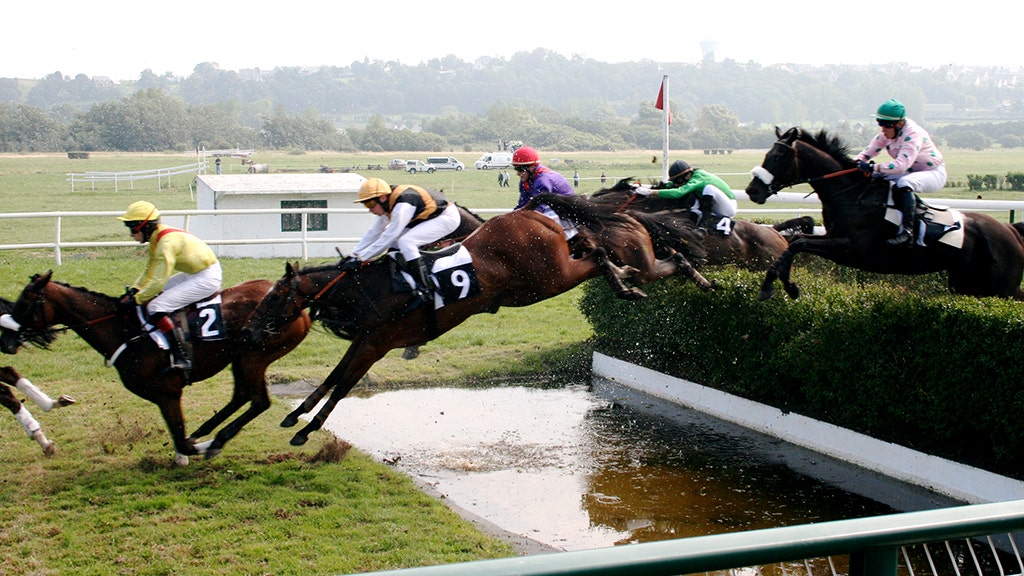The Mechanics of a Steeplechase Fall

Steeplechasing, a thrilling equestrian sport, involves horses and riders navigating challenging courses with obstacles. While the sport is exhilarating, it also carries inherent risks, with falls being a significant concern. Understanding the mechanics of a steeplechase fall is crucial for ensuring rider and horse safety and for developing strategies to mitigate the risk of injury.
Types of Falls, Steeplechase fall
Falls in steeplechase racing can occur in various ways, each with its own unique set of contributing factors. Understanding these different types of falls is essential for identifying potential hazards and developing appropriate safety protocols.
- Rider Error: Falls can be caused by rider errors such as improper positioning, loss of balance, or misjudging the obstacle. For instance, a rider may lose their balance while negotiating a fence, leading to a fall.
- Horse Error: Horses can also contribute to falls due to various reasons, including stumbling, refusing a jump, or losing their footing on the course. A horse may stumble while approaching a water jump, causing both horse and rider to fall.
- Course Obstacles: The design and condition of the course obstacles themselves can also play a role in falls. A poorly designed fence or a slippery surface can increase the likelihood of a horse stumbling or the rider losing their balance.
Causes of Falls
Falls in steeplechase racing are often the result of a combination of factors, making it difficult to pinpoint a single cause. However, common causes include rider error, horse error, and course obstacles.
- Rider Error: Riders may lose their balance while negotiating a fence, especially if they are not properly positioned or if they misjudge the obstacle. Additionally, improper use of the reins or stirrups can contribute to falls.
- Horse Error: Horses may stumble due to fatigue, poor footing, or lack of experience. They may also refuse to jump a fence, leading to a fall.
- Course Obstacles: Obstacles that are poorly designed or maintained can pose a significant risk. For example, a fence with uneven rails or a water jump with a slippery surface can increase the likelihood of a horse stumbling or the rider losing their balance.
Biomechanics of a Fall
The biomechanics of a steeplechase fall are complex and involve a variety of forces acting on both the horse and rider. Understanding these forces is essential for developing strategies to minimize the risk of injury.
- Forces Involved: During a fall, the rider and horse experience significant forces, including impact forces, rotational forces, and shear forces. These forces can cause a variety of injuries, ranging from minor bruises to serious fractures.
- Potential for Injury: The potential for injury in a steeplechase fall depends on a variety of factors, including the speed of the horse, the height of the fall, and the rider’s position at the time of the fall.
Safety Protocols and Equipment
To mitigate the risk of falls and injuries in steeplechase racing, various safety protocols and equipment are employed.
- Course Design: The design of the course plays a crucial role in safety. Obstacles are designed to be safe for both horse and rider, and the course is inspected regularly to ensure that it is in good condition.
- Rider Equipment: Riders wear protective gear, including helmets, body protectors, and boots, to minimize the risk of injury in case of a fall.
- Horse Equipment: Horses are also equipped with safety gear, including saddles, bridles, and stirrups, which are designed to be secure and comfortable.
Steeplechase fall – The dramatic fall in a steeplechase race can be a spectacle of both danger and athleticism. While the focus is often on the rider’s skill, the history and architecture of the courses themselves are equally important, as seen in the iconic quincy hall , a landmark that has witnessed countless thrilling steeplechase races.
The course’s design, with its challenging fences and undulating terrain, adds another layer of complexity to the already demanding nature of the steeplechase fall.
The steeplechase, a demanding race requiring both speed and agility, often sees competitors fall victim to the unforgiving obstacles. However, the event has also produced some of the most inspiring athletes, like Soufiane El Bakkali , who has consistently demonstrated remarkable skill and resilience in navigating these challenges.
Despite the inherent risks, the steeplechase remains a thrilling spectacle, showcasing the determination and athleticism of its participants.